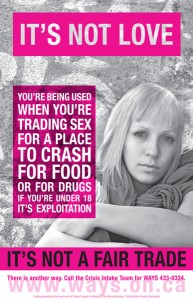There is a rather crass cynicism in the general public that at-risk youth of being homeless are on the street, or living precariously, because it is either a type of “rite of passage,” an adventure, or they are simply going through a rebellious stage of their adolescence. For the most part, such thinking is a myth. Many near-homeless or homeless youth today were thrust out of their homes forced by neglect or abuse or graduated from the foster-care system when they reached nineteen.
There are a lot of dangers a youth faces once ejected from his or her familiar surroundings. The most pervasive one is the anxiety of not have a safe place to sleep and the gnawing dread of never finding one. But the most insidious danger is that of sexual exploitation, or the draw of the sex trade to simply survive. In this week’s Monday Magazine (September 20, 2012), Simon Nattrass’ column (posted below) forcefully exposes this dark reality in our midst. His words are eloquent and his message blunt. His last paragraph hits close to the heart of the matter. Allowing any youth to be sexually exploited murders a vital spark in their inner being, that is, their living flame of self-worth that feeds their dreams and hopes.
After a long stint of living in shelters, Marie was finally doing well. She had all the right supports: housing, drug and trauma counselling, and even volunteering in the community. But when personal trauma became overwhelming and her addictions resurfaced, she couldn’t hold on to her supported housing and, once again, her only option was the street. Weeks later, she was on a corner in Rock Bay, surviving in the best way she knew how.
Marie is 18. Her name is fake, but her story is real, and others like it continue to play out day by day across the City of Gardens.  Estimates from local support and advocacy groups place the number of sex workers in The Capital somewhere between one and three thousand, and StatsCan indicates that 15 per cent of that population is under 18, giving us an estimate of 150-450 youth connected to the local sex trade. In reality, that number is probably much higher — social stigma and fear of reprisal ensure that most kids aren’t going to look a social worker in the eye and admit to trading sex for a warm bed or a fix.
Estimates from local support and advocacy groups place the number of sex workers in The Capital somewhere between one and three thousand, and StatsCan indicates that 15 per cent of that population is under 18, giving us an estimate of 150-450 youth connected to the local sex trade. In reality, that number is probably much higher — social stigma and fear of reprisal ensure that most kids aren’t going to look a social worker in the eye and admit to trading sex for a warm bed or a fix.
Further complicating any attempt to understand the extent to which youth are exploited in the local sex trade are the invisible kids — the girls who are lured to exclusive parties with the promise of drugs and then sold for sex without their consent. These are kids who never see the street.
It’s easy to offer pity, to hurl outrage at the nameless, faceless politician or corrupt bureaucrat who we assume is to blame for decimating the lives of hundreds of our community’s young people. It’s harder to recognize that these kids aren’t just victims — they are survivors, fighting tooth and nail to scrape by in the face of abuse, trauma and a community that has turned its back on them.
Make no mistake, this is our fault — yours and mine. Every time a parent forces his or her kid onto the street with abuse or neglect; every time a guardian spends his or her support money on booze instead of food; every time you call a street kid a worthless bum instead of asking what put them there in the first place; every time we ignore the problem, another young person is brutally raped in the name of survival.
